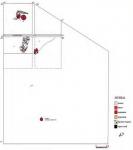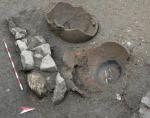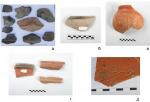Summary (English)
AGATHOPOLIS (Diana Gergova – dianagergova@gmail.com, Yavor Ivanov, Galena Radoslavova) Illicit excavations for building construction were carried on the site and the strata were partly destroyed. A pit was explored, containing charcoal and sherds of the 2nd – 1st centuries BC. A wall of the 4th – 6th centuries AD was discovered, built in rubble masonry, and two dolia (Nos. 2 and 3) containing fragments from imbrices were found close to it. Dolium No. 3 contained a bronze ladle as well and two bronze nails were found in dolium No. 2. Foundations of a building were discovered and Late Antique sherds were found around. Fragmentary tiles from the collapsed roof were discovered and traces from fire were documented. Dolium No. 4 was discovered, containing sherds from amphorae and an amphora lid of the 4th – 6th centuries AD. Two Christian burials of children (Infans ІI) were explored. Late Antique tegula was found on the skull of the child buried in Grave No. 1. Pathological malformations due to anemia were attested as well. The following finds were discovered in the earth from the illicit excavations: a melting-pot, moulds, bronze tools, terracotta loom weights, stone spindle whorls, sherds from the Early Iron Age, the Classical, Hellenistic and Roman periods, Late Antiquity, the Middle Ages and the Ottoman period, including Late Hellenistic Megarian bowls, Late Antique imported pottery from Western Anatolia and North Africa, bronze coins (a coin of Byzie minted in the 2nd century BC, a Roman colonial coin of Maximinus Thrax minted in Deultum, coins of Justin I and Justinian I, an anonymous Byzantine follis of the 11th century).
- Diana Gergova - Archaeological Institute with Museum
- Yavor Ivanov - Archaeological Institute with Museum
- Galena Radoslavova - Regional Museum of History – Razgrad
Director
Team
Research Body
- Archaeological Institute with Museum






![Download [PDF]](/excavation/skins/fasti/images/results/download_sml.png)

